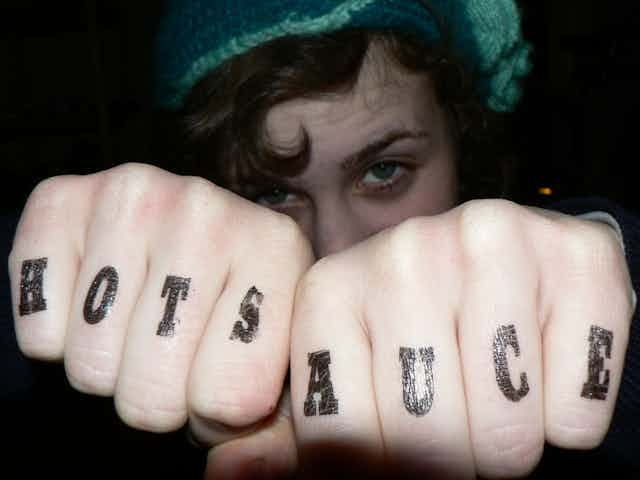A foodie, according to Ann Barr and Paul Levy, is “a person who is very, very, very interested in food”.
Cultural scholars Josée Johnston and Shyon Baumann have somewhat expanded this definition, recently describing foodies as individuals with very specific traits. Foodies are eager to learn about ingredients and cooking techniques; they crave unusual foods; and they make food an essential marker of social distinction and cultural identity. They do so by ascribing aesthetic attributes to food.

Not surprisingly, many foodies are keen to etch food-related tattoos on their skin, celebrating food’s artistic features rather than its nutritional/functional attributes. In this way foodies contribute to the fetishisation of food, making it an icon of consumer culture and a matter of taste and style.
In March 2016 McCrindle Research surveyed 1,011 Australians nationwide and found that one in five individuals have one or more tattoos (which rises to one in four among women). As tattoos become well and truly mainstream, the phenomenon of foodie tattoos has become more visible.

Food tattoos have a wide range of manifestations. The most common are vegetables and fruits, which are usually meticulously crafted. From aubergines, to strawberries, pineapples, carrots, peas, bananas, corn and asparagus, food tattoos are typically inscribed with vibrant colours and sophisticated detail, representing highly refined still-lives imprinted on human canvas.
Foodies highlight niche tastes with tattoos of cheese, ice-cream and small cakes, particularly cupcakes. Some pick tattoos of kitchen utensils. The knife is the single most common tattoo although whisks, spoons and forks, and even bulkier utensils such as free-stand and hand-held cake mixers, also appear.
While foodies use their body as a human canvas to glamorise food, chefs have long used tattoos for different purposes: as markers of nonconformity, self-promotion or resiliance in a notoriously tough industry. A recent publication, Knives & Ink, explores this connection. The book features over 60 exquisite drawings of chef’s tattoos, accompanied by the story of each design.

While some have chosen more traditional forms of calligraphy, others have proudly exhibited their star sign, favourite animals or signature dishes as a certification of trade expertise. Female chefs have also taken to tattooing with gusto.
Acknowledging that tattoos connote toughness and resilience (essential attributes in any woman working in a male-dominated industry), female chefs also confess using them to represent femininity and to replace the jewellery that chefs aren’t allowed to wear in the kitchen. Tattoos have become the trademark many chefs proudly exhibit to promote their self-image and their food.
Much of this has been written about before. However, Knives & Ink adds detailed chefs’ testimonials, some of which are poignant accounts of love, commitment, joy and pain.
One of the most common narratives is the thoughtfulness that precedes the selection of a tattoo, as each image has been seriously considered and deliberated upon. Typically, tattooing is a “work in progress”. Most tattooees have multiple tattoos, each representing a character or a story in an evolving history.

They can range from a homage to a relevant person in the chef’s life; to a token of friendship and love; from a visual depiction of a place, food or animal; to a foundational cookery motto. Joe Tomaszak, for example, has mise en place tattooed on his neck, a French phrase meaning “everything in its place”. Another chef has “quality over quantity”.
In any case, chefs are using ink as a signifier that permanently seals a commitment to something or someone with profound personal meaning.

Despite increasing acceptance, tattoos still represent a certain degree of unruliness. It’s this nonconformity that attracts many chefs, which they use to unconventionally herald personal values they hold close to their heart. Kitchen ink has come to represent social agency, rebellion, innovation, and artistic endeavour.
Inked chefs embody creativity; their tattooed bodies have become normalised and aspirational. Anthony Bourdain has matching knives-with-blood tattoos with his wife Ottavia Busia, and pastry chef Adriano Zumbo tattoos include Gene Wilder as Willy Wonka, who gave him “the dream”.
Tattoos have become a cultural marker of individuality that re-asserts control over one’s body. Simply put, tattoos are one of the building blocks of what is described as a “project of self”.
Tattoos have become part of mainstream culture because two competing conditions have been met: the shedding of stigma, and the gaining on an added veneer of glamour and cultural acceptability.
Chefs’ stardom has been a powerful tool to facilitate this process – it has normalised body artwork, rubberstamped tattoos with social and cultural capital and given chefs’ food the fetish symbolism already imprinted on their celebrity bodies. No wonder other groups of food-lovers have also become keen tattooees.
Knives & Ink: Chefs and the Stories Behind Their Tattoos by Isaac Fitzgerald and Wendy MacNaughton is published in Australia by Bloomsbury and is available now.
This article is part of ongoing series on food and culture, Tastes of a Nation.

